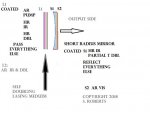Did you see the links I posted today? I think they explain what's going on.
Before I sold it to my friend, I had a 55 mW unit on a spectrometer with 0.5 nm resolution. The lasing medium shifted center wavelength outside the classic three 1120 nm yag lines by 5 nm during warmup. It also had a lasing band about 3 nm wide centered on its moving center frequency. That clearly rules out the ND 4F3/2 → 3I11/2 manifold which is the first thing I looked for, expecting the low cost laser to hop between the three discrete lines. It doesn't, it smoothly slides across a band permitted by the cavity optics.
The bandwidth of the 11xx YAG lines are no more then 2.2 nanometers, as I have a thermally tunable ND:YAG 561 in a machine at work and checked it closely by pushing the tuning.
So while I thought that at first, it would be 4F3/2 → 3I11/2. I took a good long look at the materials available. I know what it is, I spent most of the night last night doing a literature search and I have the paper stored on my laptop.
I'm just going to confirm it before I link it. I live behind an academic firewall, I have access to some search tools that Google doesn't wish to pay for. It took a couple hours after work to find the likely candidate.
If you look at the posted pictures of inside one of these it is a thin microchip laser, of a nearly transparent medium, with a coated microchip and one external mirror. It does NOT show evidence of a second crystal in the cavity.
The fact that one video shows a higher powered module hopping from a 561 green while cold to a yellow takes it right out of the historic 4F3/2 → 3I11/2 concept. ND:YAG 1123 has 1/9th the gain of 1064. It tends to need thermal stabilization to stay lasing. The cavity has to be designed to suppress 1064 to prevent it robbing power from or killing 11xx lasing. No way an Nd:YAG would flash green and switch to yellow with that design constraint.
I have a bunch of 11xx nm optics sets for Yellow Nd:YAG and they all specify a minimum of 60% transmission at 1064 on all three optics in the set to ensure it can't spontaneously lase at 1064 while trying to generate 1122. They also coat the rods to slightly reflect 1064 while AR at 1122 to prevent any 1064 lasing.
If its what I think it is, the pump diode has to have a wavelength somewhat shorter then IR wavelength being generated to comply with Stokes law, but close enough to be just above the upper manifold. Probably within 100 nm, so the pump will probably be in the 900-1100 nm range. Right where silicon in a cheap CCD spectrometer will not see it or barely see it.
This is a complex beast that has been known for a few years, but is only now hitting the market. Its not known for its ability to be scaled to high power in a thin disk or sheet similar to what is in the photo. Overdriving the low cost ones will possibly result in a cracked crystal.
Its not Neodymium in all likelihood, at all. If a Prof here agrees it is a fun learning project for one of his laser sciences students, I will probably pump it with a tunable Ti:Saph in a few weeks. It is the summer academic holiday around here for the next two weeks, so just waltzing into a borrowed lab Sunday to mooch a few minutes time on a Chameleon is not going to happen, everyone is away.
I think I know, but as stated previously, I'm no hurry to be wrong. MY hat is off to the team that developed this medium. If your having a laugh reading this thread, please enjoy.
Edit: Left out the word NOT by mistake.
Steve




